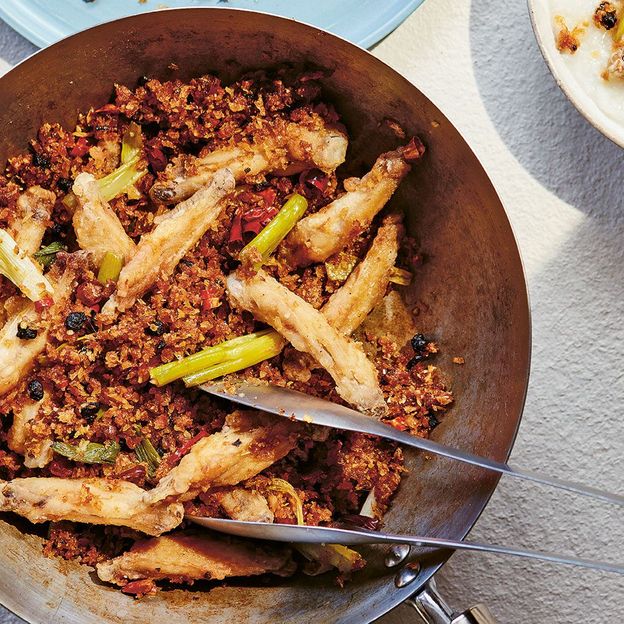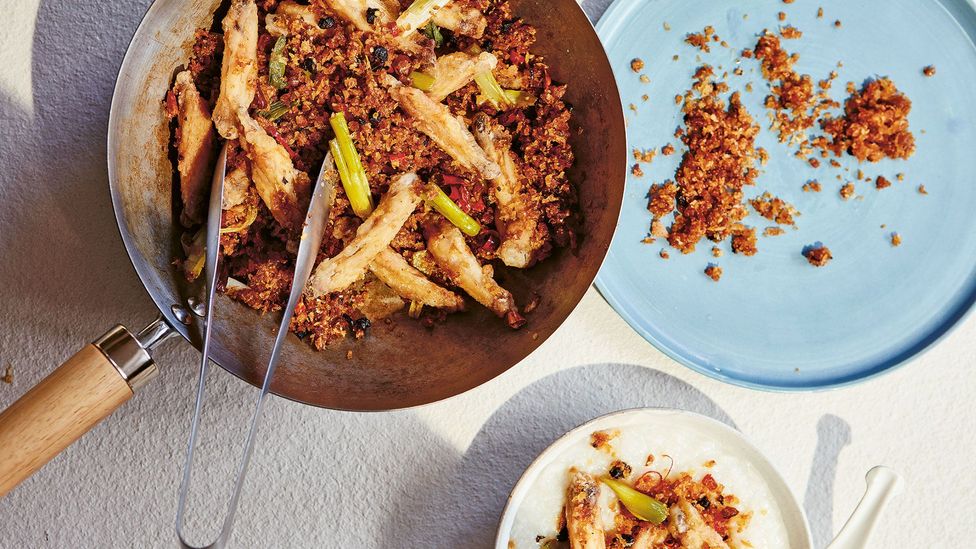Summer in Hong Kong marks the beginning of typhoon season. Cue the dense air, heavy storms and rain that can force umbrellas to break under their weight. Despite the intense downpours that typhoons bring, without them, an iconic Hong Kong dish would have never been born.
It's called typhoon shelter crab, and it was created in the 1960s on fishing boats housed in Hong Kong's many typhoon shelters.
The dish features a shell-on crab and a whopping amount of minced garlic, mixed with hints of spring onion, fermented black beans and chilli. The signature taste of the dish is deep-fried garlic with breadcrumbs and spices, with the addition of crab to absorb the intense flavours.
The dish is a signature of the typhoon shelter community, the large population of fishermen and their descendants who lived on boats in the shelters in the mid-20th century and were nicknamed "boat people". The boat population was said to originate from the Tanka native community in Hong Kong – a group of boat dwellers who resided on the southeast Chinese coast. Historically considered outcasts, this ethnic group has their own language, superstitions, wedding rituals and food, including the fiery typhoon shelter flavour.
Author Susan Jung pays tribute to the style of typhoon shelter flavours in her recent cookbook, Kung Pao and Beyond, which showcases fried chicken recipes from East and Southeast Asia. Previously, Jung was the food and wine editor of South China Morning Post (SCMP) for 25 years and had a recipe segment on SCMP's YouTube channel called Home Cooking with Susan Jung.
"Because these 'boat people' were living on small boats that lacked refrigeration, they cooked their catch with ingredients that could be kept at room temperature," said Jung. "In the case of these typhoon shelter dishes, that meant garlic, chillies and black beans."
Typhoon shelter crab stands out when compared to other Cantonese food. While most Cantonese cuisine tends to feature subtle flavours, typhoon shelter crab is one that demands attention, thanks to the mixture of those fragrant pantry ingredients stored onboard.
In the 1980s, the Hong Kong government began to implement stricter licensing rules and offered relocation schemes to move the boat population into public housing. By the 1990s, most of the boat population moved onshore, yet the typhoon shelter flavour lives on in Chinese restaurants. These days, typhoon shelters are still used as mooring spots by boats during storms but are more often used to park the city's luxury yachts.

A woman rows a sampan boat in Hong Kong's Causeway Bay (Credit: Doug Houghton/Alamy)
Visitors to Hong Kong can find the dish in numerous Cantonese restaurants, such as the popular Under Bridge Spicy Crab. However, for a real typhoon shelter experience, Shun Kee is the only remaining restaurant on a sampan boat (a type of Chinese or Malaysian small wooden boat with a shelter) located in the city's iconic Causeway Bay Typhoon Shelter. This location once served as a thriving night-time dining destination in the 1950s to 1970s, where more than 300 boats offered food or entertainment.
In Kung Pao and Beyond, Jung plays with the typhoon shelter flavour by combining it with fried chicken. While it's not a pairing that's usually seen in Hong Kong, the flavour is so fragrant and adaptive that it could work with almost every protein.
"It's very garlicky, very pungent, quite spicy, and very strong flavours," she said. "You start eating it and you think [the chef] must use MSG [monosodium glutamate]'." But there's no MSG involved – this dish is just naturally addictive.
Garlic is undoubtedly the star ingredient that makes the dish pop. Jung's recipe calls for 200g of peeled garlic cloves, and she recommends using a food processor to save time mincing. Garlic presses won't work for this recipe, as they'll turn the garlic into a puree.
The recipe begins by coating the chicken wings with flour and then frying them in a wok, says Jung. After the wings are cooked through, they are removed from the oil and a fresh batch of oil is swapped in for toasting and browning the breadcrumbs and garlic. To help brown the mixture, Jung adds a spoonful of sugar while cooking. When the breadcrumb and garlic mixture is toasted, the wings are added back to the wok and everything gets a good stir to help the flavour permeate the meat.
To serve, Jung suggests pairing the fried chicken with rice or congee and stir-fried vegetables. "Because the flavours are so strong, you need something subtle like stir-fried vegetables to balance the flavours," she said. "You don't want to serve it with another dish that's also strongly flavoured."

These crispy chicken wings are stir-fried with garlic, onion and chillies (Credit: Yuki Sugiara)
Typhoon Shelter Wings recipe
By Susan Jung
Serves 4-6
These crispy fried wings are inspired by classic typhoon shelter crab: large, shell-on crab that's been cut into pieces, deep-fried, then stir-fried with loads of garlic, spring onions and chillies. This style of cooking can be used for other ingredients, including prawns, fish, tofu and chicken.
At restaurants, diners choose the crab they want and indicate the spice level: for most people, medium is spicy enough. Select the number of chillies you would like to use depending on your heat tolerance.
Ingredients
1kg (about 2½ lb) mid-joint chicken wings (also called flat wings or wingettes)
1 tsp coarse salt flakes, plus more for seasoning
20g (about 1 tbsp) fermented black beans
1 tbsp soy sauce
10 to 15 dried Tianjin chillies (or other types of small, whole dried chillies), rinsed and dried
120g (4¼oz) potato flour or sweet potato flour, plus more as needed
870ml (3¾ cups) cooking oil
100g (3½oz) panko breadcrumbs
200g (7oz) peeled garlic cloves, roughly chopped
1½ tsp granulated sugar
6-12 red bird's-eye chillies, cut into thin rings and seeded
120g (4¼oz) spring onions, cut into 5cm (2 in) pieces
Method
Step 1
Cut the wings in half lengthwise between the bones, then put the pieces in a bowl. Weigh the wings, then multiply the amount by 0.01 – this is the amount of salt you need. Sprinkle the salt over the wings, then mix well.
Step 2
Briefly rinse the black beans, then put them in a small bowl and add 40ml (2 tbsp + 2 tsp) warm water and the soy sauce. Halve the Tianjin chillies, shake out and discard the seeds, then slice the chillies into thin rings.
Step 3
Dredge the wings in the flour, then lay them on a cooling rack placed over a tray. Leave them to air-dry for at least 10 minutes, then coat them again.
Step 4
Pour 750ml (3¼ cups) of the cooking oil into a medium wok or deep pan, and heat to 160C/320F over medium heat. In 4 to 5 batches, fry the chicken for 3 minutes, then drain on the rack placed over the tray. After frying the last batch, fry the wings again for 1 minute at 170C/340F.
Step 5
Place a large wok over medium heat and add the remaining 120ml (½ cup) of cooking oil to 100C/212F. Add the panko, garlic, sugar and 1 teaspoon of salt. Stir almost constantly until the panko and garlic are pale golden, about 2 to 5 minutes. Mix in the black beans and its steeping water, along with both types of chillies and the spring onions and cook, stirring, for about 2 minutes, or until the wok is dry.
Step 6
Taste for seasonings and add more salt and sugar, if necessary. Add the wings and cook, stirring, for about 3 minutes longer, or until the wings are hot. Pile onto a platter and serve.
Note
The garlic and breadcrumb mixture left over after the wings are eaten can be kept in the fridge for at least a week. It's delicious with rice or congee or sprinkled over scrambled eggs or stir-fried vegetables.
Recipe adapted from Kung Pao & Beyond by Susan Jung (Quadrille, 2023). Photography © Yuki Sugiara.
BBC.com's World's Table "smashes the kitchen ceiling" by changing the way the world thinks about food, through the past, present and future.
---
Join more than three million BBC Travel fans by liking us on Facebook, or follow us on Twitter and Instagram.
If you liked this story, sign up for the weekly bbc.com features newsletter called "The Essential List". A handpicked selection of stories from BBC Future, Culture, Worklife and Travel, delivered to your inbox every Friday.
